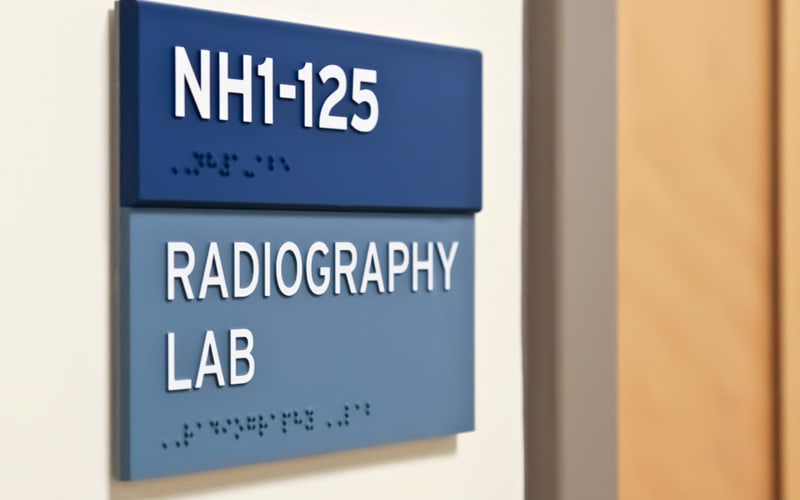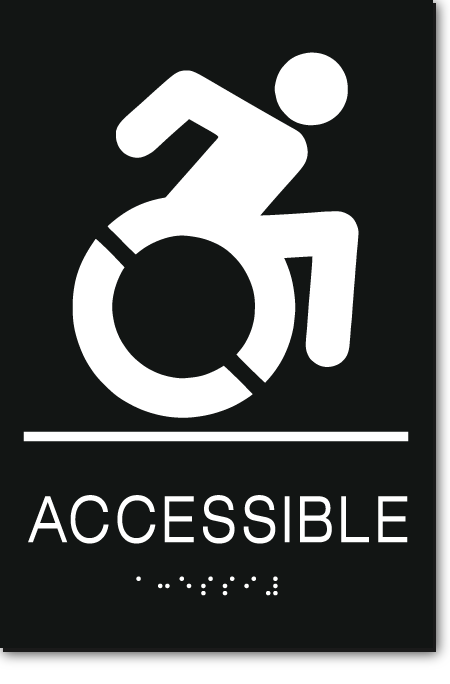Understanding the Regulations Behind ADA Signs
Understanding the Regulations Behind ADA Signs
Blog Article
ADA Signs: Guaranteeing Availability and Compliance in Public Spaces
ADA signs plays an essential function in ensuring access and conformity within public spaces, dramatically adding to an inclusive setting for people with impairments. By sticking to ADA criteria, signage not only facilitates navigation but likewise highlights an organization's commitment to variety and equal rights. As we explore the subtleties of ADA signage, from responsive features to develop ins and outs, it's essential to consider how these aspects coalesce to copyright the civil liberties of all individuals. What are the usual challenges organizations face in keeping compliance, and exactly how can future fads in signs proceed to drive availability forward?
Significance of ADA Signage
In modern culture, the relevance of ADA signage extends past plain conformity with legal requireds to embody a dedication to inclusivity and access for all individuals. These signs are important in developing environments where people with disabilities can navigate public spaces with the very same simplicity and independence as those without handicaps. By supplying clear and standardized details, ADA signs makes sure that everyone can access centers, services, and information without obstacles.
The significance of ADA signs exists in its ability to boost the top quality of life for people with specials needs by advertising equivalent gain access to. It gets rid of the barriers that might or else hinder their capacity to get involved completely in neighborhood life. These signs serve as visible indications of an organization's devotion to variety and equal rights, reflecting broader societal values that promote the rights and self-respect of all people.
Moreover, ADA signs plays an important role in public safety and security. By leading individuals to exits, toilets, and various other vital centers, it ensures that all people, despite physical capacity, can leave safely during emergency situations. In summary, ADA signs is not simply a regulative demand but a powerful device for promoting a equitable and comprehensive society.
Crucial Element of Conformity

Placement is important; indicators have to be installed in locations that are conveniently noticeable and reachable. Usually, signage ought to be mounted in between 48 and 60 inches from the ground to make certain access for both standing and wheelchair individuals. Responsive elements, such as Braille, are essential for individuals with aesthetic disabilities, supplying important details in a non-visual layout.
High-contrast shades between the message and history are needed to enhance readability for people with reduced vision. The ADA mandates specific contrast ratios to ensure clearness. In addition, character dimension is a crucial factor to consider, with minimal elevation needs determined by the viewing distance to make certain readability from different angles.
Design Factors To Consider for Ease Of Access
Creating easily accessible signage requires a precise approach to ensure it satisfies the needs of all customers, especially those with impairments. This involves taking into consideration numerous style components that improve readability and functionality. Trick elements include the selection of font, shade contrast, and responsive attributes. Typefaces need to be sans-serif, with basic and clear letterforms, to facilitate very easy analysis. The dimension of the message is just as critical, with ADA guidelines recommending a minimal elevation based upon watching distance to make sure readability.
Contrasting colors in between message and history are crucial for visibility, especially for people with aesthetic disabilities. Additionally, tactile components, such as Braille and increased characters, are crucial for individuals that are blind or have low vision.
In addition, the positioning of signage plays a considerable duty in accessibility. Signs ought to be installed in places that are unblocked and quickly reachable. Guaranteeing that signs is placed at ideal heights and angles enables all users, including those utilizing mobility devices, to connect with them effectively.
Common Blunders to Avoid

An additional widespread error is the inaccurate placement of signs. ADA guidelines specify specific elevation and area needs to ensure that indications are conveniently noticeable and reachable by all individuals, consisting of those making use of wheelchairs. Ignoring these standards not just hampers ease of access yet additionally risks non-compliance with legal requirements.
Additionally, inadequate contrast between text and background is a constant oversight. Adequate contrast is vital for readability, especially for people with low vision. Developers sometimes pick colors that are aesthetically enticing but lack the necessary contrast, making the text challenging to discern.
Finally, some developers fail to integrate responsive components, such as Braille, which are crucial for individuals that are blind. Omitting these features not just results in non-compliance with ADA laws yet likewise restricts gain access to for a section of the populace that depends on tactile details.
Future Trends in Signs
Developments in modern technology and enhancing awareness of inclusivity are shaping the future fads in signage design. As society becomes a lot more aware of diverse requirements, the assimilation of smart innovations into signage is obtaining traction. Digital signs, for example, is developing to try these out include real-time updates and interactive features, which can be critical in giving vibrant information in public rooms. These indications commonly include touch displays or gesture-based controls, see post making it possible for customers to browse content tailored to their specific needs.
An additional arising pattern is the use of increased reality (AR) to boost user experience. AR-enabled signs can overlay digital information onto the physical atmosphere, offering visually impaired individuals with auditory or haptic comments. ADA Signs. This innovation not just enhances availability but additionally creates an engaging experience for all customers
Sustainability is additionally a substantial aspect influencing signs patterns. Green materials and energy-efficient lighting options are being focused on to line up with global environmental goals. Additionally, innovations in materials science are causing the growth of even more weather-resistant and resilient indications.
Final Thought
ADA signage plays a vital duty in ensuring ease of access and conformity within public areas by including responsive elements, high-contrast colors, and tactical positioning. The adherence to ADA requirements not only assists in safe navigation for individuals with specials needs yet also indicates an organization's devotion to variety and inclusivity. By preventing common mistakes and welcoming future patterns, public spaces can remain to advance these values, ensuring that the legal rights and dignity of all people are appreciated and upheld.
ADA signs plays a crucial duty in ensuring ease of access and compliance within public spaces, substantially adding to an inclusive setting for individuals with impairments. As we discover the subtleties of ADA signage, from tactile attributes to create complexities, it's crucial to consider how these elements coalesce to copyright the rights of all customers.In contemporary society, the value of ADA signage prolongs past plain conformity with legal requireds try this out to symbolize a dedication to inclusivity and availability for all people. By giving standard and clear information, ADA signage makes sure that every person can access facilities, solutions, and information without obstacles.
ADA signs plays an essential function in guaranteeing access and compliance within public spaces by including tactile elements, high-contrast shades, and strategic placement. (ADA Signs)
Report this page